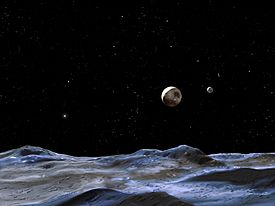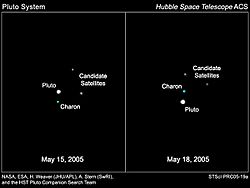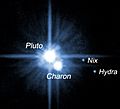Hydra (moon) facts for kids
Hydra is the farthest moon of Pluto. It was found along with Nix in June 2005. The Hubble Space Telescope's Pluto Companion Search Team discovered it. This team included scientists like Hal A. Weaver and Alan Stern.
The first pictures showing Hydra were taken on May 15 and May 18, 2005. Scientists Max J. Mutchler and Andrew J. Steffl found the moons independently. The discovery was announced on October 31, 2005. This happened after older pictures from 2002 confirmed the moons were there. Hydra was first called S/2005 P 1.
 Artist conception of Hydra (foreground), Pluto and Charon (background), and Nix (bright dot center left) |
|
| Discovery | |
|---|---|
| Discovered by | Hubble Space Telescope Pluto Companion Search Team |
| Discovered in | June 2005 |
| Orbital characteristics | |
| Semi-major axisa | 64 780 ± 90 km |
| Eccentricity | 0.005 ± 0.001 |
| Orbital period | 38.206 ± 0.001 d |
| Inclinationb | 0.22° ± 0.12° |
| Is a moon of | Pluto |
| Physical characteristics | |
| Mean diameter | 61 − 167 km |
| Mass | 5×1016 − 2×1018 kg |
| Mean density | unknown |
| Rotation period | unknown |
| Axial tilt | unknown |
| Albedo | 0.04 − 0.35 (assumed) |
| Apparent magnitude | 22.9 to 23.3 (measured) |
| Surface temp. | 33-55 K |
| Atmosphere | none |
|
|
|
| a Relative to the Pluto-Charon barycenter. b Relative to Pluto's equator (also Charon's orbital plane). |
|
Contents
Hydra's Orbit Around Pluto
Hydra travels around the center of mass of the Pluto system. This center is called the barycenter. It orbits in the same flat path as Charon and Nix. Hydra is about 65,000 km away from this center.
Unlike Pluto's other moons, Hydra's path is not perfectly round. It is only nearly circular. Its orbit takes about 38.2 days to complete one full trip.
Size and Appearance of Hydra
Scientists have not measured Hydra's exact size yet. But they can guess its size based on how bright it looks. If Hydra reflects light like Charon (35 percent), it would be about 61 km wide. If it reflects light like very dark objects in the Kuiper belt (4 percent), it could be about 167 km wide.
When Hydra was first found, it seemed about 25 percent brighter than Nix. This made scientists think Hydra was about 10 percent bigger. But later observations from the Hubble Space Telescope showed Hydra was still a little brighter. Hydra looks grey, just like Charon and Nix. However, Pluto itself has a reddish color.
Visiting Hydra with New Horizons
The New Horizons spacecraft flew past Pluto in 2015. It also visited Hydra during its journey. This mission helped us learn more about Pluto and its moons.
How Hydra Got Its Name
The name Hydra was officially announced on June 21, 2006. It was also given the formal designation Pluto III. Hydra is named after a monster from Greek mythology. This monster guarded the waters of Pluto/Hades's underworld.
| The Solar System | |||||||
|---|---|---|---|---|---|---|---|
|
|
|||||||
| Sun • Heliosphere |
Planets ☾ = moon(s) ∅ = rings |
Mercury | Venus | Earth ☾ | Mars ☾ | ||
| Jupiter ☾ ∅ | Saturn ☾ ∅ | Uranus ☾ ∅ | Neptune ☾ ∅ | ||||
| Dwarf planets | Ceres | Pluto ☾ | Haumea ☾ | Makemake | |||
| Eris ☾ | |||||||
| Small Solar System bodies |
Asteroids (minor planets) |
Groups and families: Vulcanoids · Near-Earth asteroids · Asteroid belt Jupiter Trojans · Centaurs · Neptune Trojans · Asteroid moons · Meteoroids · Pallas · Juno · Vesta · Hygiea · Interamnia · Europa |
|||||
| See also the list of asteroids. | |||||||
| Trans- Neptunians |
Kuiper belt – Plutinos: Orcus · Ixion – Cubewanos: Varuna · Quaoar · Huya |
||||||
| Scattered disc: Sedna | |||||||
| Comets | Periodic comets and non-periodic comets Damocloids · Oort cloud |
||||||
| See also the list of solar system objects | |||||||
Images for kids
See also
 In Spanish: Hidra (satélite) para niños
In Spanish: Hidra (satélite) para niños



